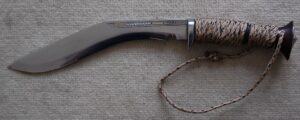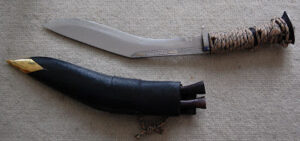I am a great admirer of the kongo, and once wrote an article on the manrikigusari so it was only natural that the tenouchi would interest me. Tenouchi (“inside the hand”) is a term that has several meanings in Japanese and can mean just a yawara stick or a small hand weapon.
The tenouchi we are considering is a kongo or yawara stick with a cord attached to its middle. This cord is tied so that it forms a figure eight shape.
So I grabbed a bit of scrap broomstick and some paracord and got carving. Here is my first attempt with a kongo beside it.

This particular example has a 6" handle. Most of my kongos area around 5" so I carved a 6" for variety. I am very pleased with the shape of this one but later learnt that tenouchi handles tended to be smaller so that they could more easily slip between the loops of the cord. Serge Mol’s “Classical Weaponry of Japan” gives dimensions as being about 16cm, while Don Cunningham’s “Secret Weapons of Jujutsu” shows a handle that looks to be 7-8". I’ve had no problems with my 6" handle but if you are making your own you should start with a handle that should be just long enough so that there is enough to strike with on either side of your hand.


The cord part was given as 180 cms in Mol's book, which happenes to be my height. If you are significantly shorter or taller than this you might consider using your own height to get the proportions right. The cord was threaded through the hole drilled in the handle and tied in a figure eight. I tied an loose overhand knot in the very centre of the cord, threaded the free ends through it and then tied a fisherman’s knot whose two halves pulled tight against the central overhand. This is a very neat way of making the figure eight.
The first method is to hold the handle in your strong hand, the cord projecting between the second and third fingers. Hold the end of the cord in your other hand. With this hold attacks can be parried with the stretched length of cord. Attacking limbs can be wrapped and manipulated with the cord. See my article on the manrikigusari for some ideas. The cord can also be looped over the head to pull, throw or garrotte. The handle is a kongo, so can strike with either end or can be used to assist in lock or bone-crushing (koppo) techniques.
On the second method the handle is held as before but the far loop is thrown over the strong hand so it rests across the top of the forearm. The loops of cord hang down under the arm. The hanging cord can be slipped over a limb or the neck and the handle pulled through the distal loop. This forms a noose. The rest of the cord can be looped around other body parts to bind the enemy and pull the noosed limb against the torso and immobilize it. One interesting variation is to lower the cord, place your foot on it and pull on the handle to bring your foe down to the ground.

The third method may not be traditional, but is something I came up with in experimentation. Hold the handle as before and slip the distal loop over your first two fingers. Release the handle and twirl the weapon around by wrist action. This makes an impressive noise. With a light wooden handle such as mine this is mainly an intimidation and hazing technique. Possibly the spinning cord could be wrapped around a limb and the free end caught in the other hand. Some tenouchi have metal handles and these might have been more effective striking weapons when flailed. From this hold I found it was possible to slip the end loop over the top of the handle using your forefinger. The hanging loops could then be hooked over an enemy and the handle pulled through with thumb and forefinger to form the noose described in the second method.








